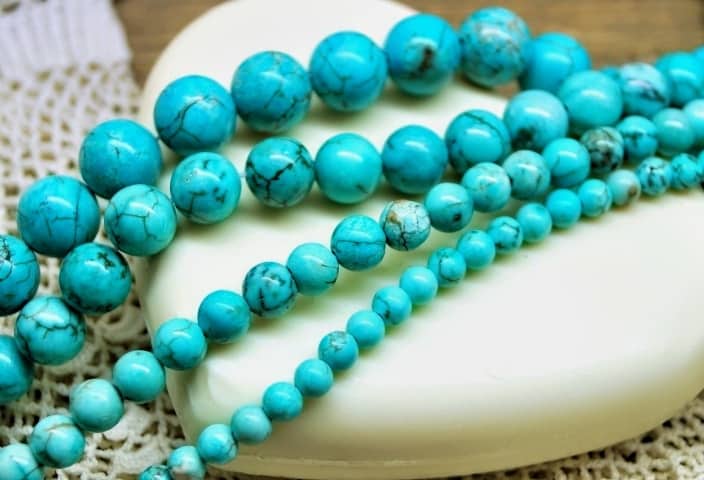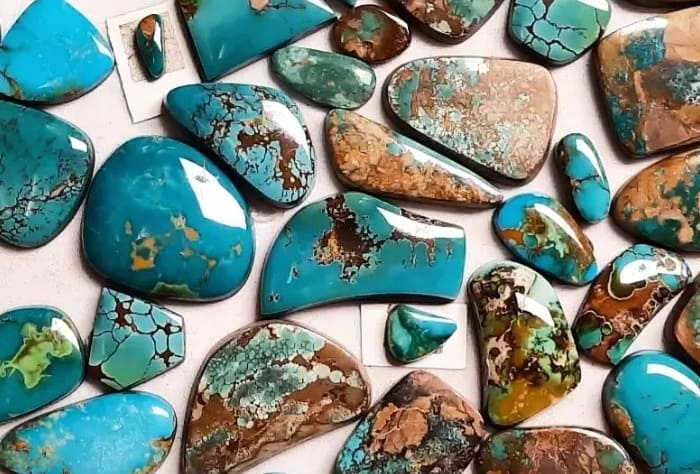Turquoise is quite popular due to its stunning bluish-green colors, extensive use in jewelry, and beadwork. With the popularity and high demand come fakes and imitations.
When shopping for higher-end turquoise jewelry the last thing you want to do is purchase what you believe to be turquoise when in all actuality it’s fake. So, I’ve put together a list of things you can do to authenticate the turquoise while purchasing your favorite pieces.
During my time at gem and mineral shows, I’ve seen quite a few gem dealers selling fake turquoise but online retailers are way worse because you have to go by the photos and are unable to inspect the stones before purchase. If and when you can, you should purchase stones from a reputable gem dealer or a seller you’ve interacted with in person. I’ve put together a guide for identifying turquoise to assist you with your next purchase.

What is Fake Turquoise?
As you can see from the picture of fake Turquoise, gem dealers typically use a cheaper, more common mineral called Howlite but don’t be surprised if you see various plastics and glass being sold as authentic turquoise. Unlike Howlite, imitation Turquoise made from cheap plastics and glass is very easy to spot due to its perfect color and high polish.
Howlite is a naturally occurring, beautiful white mineral that is part of the borate family. Due to its porosity, howlite accepts dyes very easily and thus is used to imitate turquoise. These soft howlite cabochons, beads, or carved pieces are the most common candidates for fake turquoise. Dyes are simply applied to Howlite’s surface, which is slowly absorbed into the porous interior. This makes it good at holding colors and shades.
It’s important to know when you’re getting real turquoise. People may trick you into buying a less valuable, cheap crystal at a higher price. Below we’ll show you the steps to determine whether you’re turquoise is real or not.

Ways to Determine if Turquoise is Real or Fake
I’m a graduate gemologist from GIA and I’ve put together a simple guide on identifying fake turquoise. I’ve done my best to lay it out in a way that allows you to determine real or fake turquoise while purchasing online or in person.
There are various ways to identify turquoise but we will be using a method I learned while attending the Gemological Institute of America. Enough about me and the process, let’s take a deeper look into how to spot authentic turquoise like a pro.
Hardness or Scratch Test
Turquoise is higher up on the Moh’s scale of hardness which means it won’t scratch as easily as howlite. With an average hardness of 5-6, this makes the scratch test very effective because howlite is closer to a 2. You can easily chip or scratch howlite with your fingernail or a coin.
Color
Turquoise is an opaque mineral which means you won’t be able to see any visible light transfer through the stone. This is fairly easy to confirm or deny if you have a penlight on hand. Like most novice buyers, you don’t have a penlight handy. So, we move to the next visible test which is the surface color.
To become proficient at spotting fake turquoise then you’ll need to spend time looking at lots of fake dyed howlite. You’ll notice the veins in the howlite are more flowy in nature, similar to marble. While turquoise has harder turns or edges to the streaks of black or brown.
The blue color in howlite is produced from a dye and the absorption is not uniform which means the dye will be heavier in some areas while much lighter in other sections.
In my experience, the best example of dyed howlite is the scarab. You’ll see these in stores and gem shows being sold by lower-end dealers. If you run across these, then spend some time inspecting them so you build your visual knowledge bank on what dyed howlite looks like.
Cost
If it’s too good to be true then it probably is. Turquoise is a semi-precious gemstone and high-quality material can be expensive for what it is. When you come across a beautiful blue turquoise and the dealer is selling it at a major discount then it’s probably fake
Beaded Necklace and Bracelet Test
This test goes perfectly with the cost analysis. When you see a beaded necklace or bracelet and the online store or dealer is claiming its turquoise then look for knots. If you the turquoise is high quality then there should be a knot between every bead.
You’re probably wondering why should the necklace or bracelet have knots. Well, turquoise isn’t cheap, and if the necklace or bracelet breaks you don’t want to lose all of the beads. The knots keep the beads from falling off the string.
Plus, knotted bracelets and necklaces take more time and cost more money. Dealers won’t spend the extra dollars to have it done on dyed howlite.

Closing Thoughts
We hope this simple “how to” guide on spotting fake turquoise helped you find the real deal!
You should feel confident in using the visual part of this guide the most and you’ll get better as you interact with more gemstones. Before you know it, you’ll be identifying stones like a gemologist.
If you run into any issues or you get confused then feel free to reach out and I’ll do my best with assisting you in the identification process.
How Can You Determine if Turquoise is Real Before Buying It?
If you’re shopping for turquoise, you can test it with your fingernail. However, you’ll want to avoid permanently damaging the sample. We recommend using color, transparency, and texture to determine its authenticity.
- Identify Enstatite - March 12, 2024
- Identify Cerussite - March 3, 2024
- Identify Bytownite - February 18, 2024

2 Responses
What about looking at the material under a loupe before doing more invasive things like acetone or scratch testing?
In my case, I was sold Sleeping Beauty gold-filled earrings and a matching necklace on Etsy. In looking at it under a loupe the areas that appear to have “marbling” contain reflective pieces of silver. (Also heard that turquoise should be magnetic due to the copper content but these were not.) Would traces of *silver* be expected to happen with Howlite or other turquoise substitutes?
On another source (certain home shopping TV channel known for jewelry sales) it was claimed recently that Sleeping Beauty is a robin’s egg blue that does not have veining or marbling. Minutes later they showed a necklace made out of rough (irregular shaped pieces of stone) and it was obvious that, yes, Sleeping Beauty turquoise also has variations in color and marbling/veining. (To my eye, in fact, “perfect” Sleeping Beauty turquoise with no evidence of veining is too easily confused for a faux gemstone so I somewhat prefer the irregularities that Sleeping Beauty set into mass-produced jewelry generally lacks.)
On a final note, is there any way to tell Sleeping Beauty from Kingman or other sources of American turquoise? So to cite my example, since my “Sleeping Beauty Turquoise” contains some black (silver upon closer inspection) marbling and is more of a Blue-green than Robin’s egg blue, could it be “real” turquoise — just not Sleeping Beauty as the source? If so, what is the best way to tell?
Visual inspection with the naked eye, 10x loupe, or 40x microscope is the foundation to identifying stones. It should be the first activity you do when determining the identity of a gemstone.
Sleeping beauty turquoise question – Yes, there will always be variations and exceptions when it comes to any gemstone. Mother Nature is not perfect and she won’t produce perfect stones. Can you have Sleeping Beauty with inclusions, marbling? Yes.
Certain mines and locations are known to produce higher quality material and the gem dealers love to sell you this material at a higher price.
How to tell the difference between Sleeping Beauty and Kingman? I’d look at and handle material from both locations and see if you can determine any major differences between visual inspection. At the end of the day, they’re turquoise.